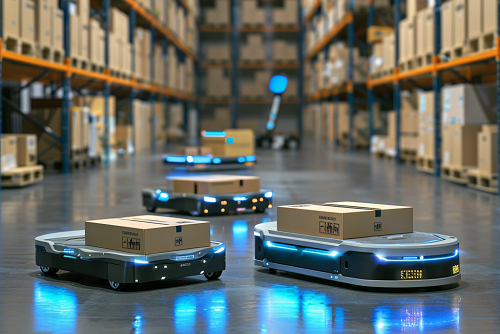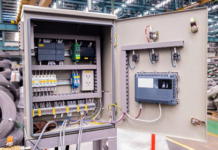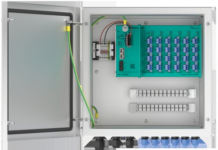
The rise of Autonomous Mobile Robotics (AMR) has transformed industries across the globe, bringing new levels of efficiency, safety, and innovation. By 2025, the integration of AMRs into various sectors will be more profound than ever before, altering workflows, reducing costs, and opening up new possibilities. As we look toward the future, it’s clear that Autonomous Mobile Robots will play a key role in the continued evolution of industries ranging from manufacturing to healthcare. In this article, we explore the top 10 industries revolutionized by Autonomous Mobile Robotics in 2025, highlighting the most significant impacts and the future trends to expect.
1. Manufacturing: Paving the Way for Smart Factories
In the manufacturing sector, Autonomous Mobile Robotics are making waves by streamlining production lines, improving quality control, and enhancing the efficiency of the entire process. By 2025, AMRs will be pivotal in transitioning factories into “smart” environments where robots work autonomously to handle raw materials, transport products between stations, and even conduct routine maintenance tasks.
- Benefits: AMRs are reducing human error, minimizing downtime, and increasing throughput. These robots are capable of navigating complex factory layouts, allowing manufacturers to optimize space and reduce bottlenecks.
- Future Trends: Manufacturers will increasingly rely on AMRs for predictive maintenance, where robots can detect and fix issues before they cause significant production delays.
2. Logistics and Warehousing: Speeding Up Supply Chain Operations
The logistics and warehousing industry is perhaps one of the most impacted by Autonomous Mobile Robotics. These robots are designed to move goods efficiently within warehouses, significantly reducing the need for human labor while enhancing the accuracy of order fulfillment. With the rise of e-commerce, companies are seeking ways to handle the ever-growing demand for faster deliveries. AMRs are answering this call.
- Benefits: AMRs in warehouses can transport goods, sort inventory, and assist in last-mile delivery, making logistics operations faster and more cost-effective. Their ability to work continuously and integrate with Warehouse Management Systems (WMS) makes them indispensable.
- Future Trends: By 2025, Autonomous Mobile Robotics will be more seamlessly integrated into global supply chains, with robots collaborating with AI and machine learning to optimize routing, inventory management, and even customer service.
3. Healthcare: Enhancing Patient Care and Hospital Operations
The healthcare industry stands to gain immensely from the use of Autonomous Mobile Robots. Hospitals and medical facilities are increasingly turning to AMRs for tasks like disinfecting rooms, delivering medications, and transporting linens and medical supplies. These robots are especially useful in environments where efficiency and safety are paramount.
- Benefits: AMRs help improve operational efficiency by automating routine, time-consuming tasks. They also contribute to infection control by reducing human-to-human contact, a crucial factor in the healthcare sector.
- Future Trends: By 2025, AMRs will play a larger role in telemedicine and diagnostics, working alongside medical professionals to enhance patient outcomes through faster, more accurate data collection and analysis.
4. Retail: Shaping the Future of Shopping Experiences
In retail, the deployment of Autonomous Mobile Robotics is helping stores operate more efficiently and provide better customer experiences. AMRs can be found assisting in inventory management, guiding customers, and even handling checkout tasks, all of which contribute to a more seamless shopping experience.
- Benefits: Retailers are leveraging AMRs to automate stock replenishment, monitor inventory levels, and optimize store layouts. Robots can even assist with shelf scanning and maintenance, reducing human labor costs and improving store efficiency.
- Future Trends: As robots become smarter, retailers will see Autonomous Mobile Robotics playing a significant role in customer interactions, personalizing the shopping journey and driving engagement through AI-based recommendations and support.
5. Agriculture: Transforming Farming Practices
In the agricultural industry, Autonomous Mobile Robotics are revolutionizing the way crops are grown, harvested, and transported. Robots are now being used to monitor plant health, automate irrigation systems, and even harvest crops, reducing the reliance on manual labor and increasing efficiency in an industry that is traditionally slow to adopt new technology.
- Benefits: AMRs in agriculture are improving productivity by enabling more precise farming techniques, such as automated planting and targeted fertilization. This leads to better crop yields and more sustainable farming practices.
- Future Trends: By 2025, AMRs will be more integrated into precision agriculture, using AI to analyze soil conditions, weather patterns, and crop health to optimize farming decisions.
6. Construction: Improving Safety and Productivity
In the construction industry, Autonomous Mobile Robotics are enhancing both productivity and safety on job sites. Robots are being used to transport building materials, assist with excavation, and even conduct inspections of structures under construction. This reduces risks for human workers and accelerates the construction process.
- Benefits: AMRs can work in hazardous environments, handling tasks that are dangerous for human workers, such as lifting heavy loads or performing inspections in unsafe conditions. They can also improve project timelines by handling repetitive tasks.
- Future Trends: The construction sector will increasingly rely on AMRs to conduct autonomous inspections, improving safety and minimizing the risk of costly mistakes.
7. Hospitality: Improving Efficiency and Customer Service
In the hospitality industry, Autonomous Mobile Robotics are enhancing the guest experience by automating tasks like room service delivery, cleaning, and even concierge services. AMRs are helping hotels and resorts improve operational efficiency while offering a more personalized experience to guests.
- Benefits: AMRs help reduce labor costs while allowing employees to focus on more critical tasks, such as guest interactions. For example, room service robots can deliver food directly to guests’ rooms, while cleaning robots can autonomously clean hotel rooms or common areas.
- Future Trends: By 2025, Autonomous Mobile Robotics will be used in guest-facing roles, such as check-in/check-out and providing entertainment or information about hotel amenities, making the hospitality experience smoother and more efficient.
8. Mining and Extraction: Enhancing Operations in Hazardous Environments
The mining industry is one of the most dangerous sectors in the world, with workers exposed to extreme conditions. Autonomous Mobile Robotics are changing that by performing tasks such as transporting materials, conducting surveys, and ensuring safety on the job site without putting human lives at risk.
- Benefits: AMRs are capable of performing repetitive and dangerous tasks in harsh environments, significantly improving worker safety. They can also assist in real-time data collection, providing insights for better decision-making.
- Future Trends: By 2025, mining companies will use Autonomous Mobile Robotics to autonomously navigate tunnels, conduct inspections, and optimize mining operations for higher productivity and lower environmental impact.
9. Defense and Security: Improving Surveillance and Tactical Operations
The defense and security industries are adopting Autonomous Mobile Robotics for a wide range of applications, from surveillance and reconnaissance to search-and-rescue missions. AMRs provide enhanced capabilities for monitoring areas that are too dangerous for humans and can be used for tactical operations, including bomb disposal and perimeter security.
- Benefits: AMRs can operate in high-risk environments, providing real-time data and analysis. They also help military and security forces perform operations more effectively, reducing the need for human intervention in hazardous situations.
- Future Trends: By 2025, Autonomous Mobile Robotics will be an essential part of national security infrastructure, offering improved surveillance, remote monitoring, and tactical support in conflict zones.
10. Environmental Monitoring and Conservation: Aiding Sustainability Efforts
In the environmental sector, Autonomous Mobile Robotics are being used for monitoring ecosystems, conducting environmental surveys, and even assisting with conservation efforts. These robots are helping scientists collect data on biodiversity, water quality, and air pollution, contributing to sustainability initiatives.
- Benefits: AMRs are designed to work in remote or challenging environments, collecting data that would otherwise be difficult or dangerous for humans to obtain. This data is crucial for understanding climate change, preserving biodiversity, and managing natural resources.
- Future Trends: By 2025, Autonomous Mobile Robotics will play a key role in large-scale environmental monitoring, supporting conservation efforts through real-time data collection and analysis.
The Growth of Autonomous Mobile Robotics Market
The Autonomous Mobile Robotics market is experiencing explosive growth, and this is set to continue into 2025 and beyond. According to Persistence Market Research, the global AMR market is expected to be valued at US$5.1 billion in 2025, and it is projected to reach US$13.6 billion by 2032, growing at a compound annual growth rate (CAGR) of 15.1% during the forecast period from 2025 to 2032. This rapid expansion is a direct result of the increasing adoption of AMRs across various industries, as they continue to demonstrate their value in improving efficiency, safety, and cost-effectiveness.
The Future of AMRs in Industry
As we move toward 2025, it’s clear that Autonomous Mobile Robotics (AMR) will continue to revolutionize industries across the globe. Whether it’s improving efficiency, enhancing safety, or opening up new opportunities for innovation, AMRs are a driving force behind the transformation of business operations. As more industries embrace automation, the capabilities of AMRs will continue to expand, offering unprecedented levels of productivity and operational excellence.
If you’re looking to stay ahead of the curve in your industry, it’s crucial to explore how Autonomous Mobile Robotics can play a role in your operations. From manufacturing to healthcare and beyond, AMRs are poised to redefine what’s possible in a wide range of sectors. So, whether you’re part of a large corporation or a small startup, embracing this technology could be your key to success in 2025 and beyond.
















